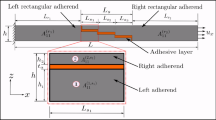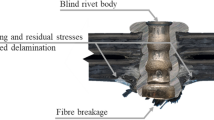Abstract
A Representative Volume Cell (RVC) chosen to epitomize the entire three dimensional four-directional braided composites is investigated to evaluate the mechanical behavior of the material by computational micromechanics. In addition to including several damage modes of braid yarn and matrix within the braided composites, the numerical model also takes into account interface damage mode by using a Cohesive Zone Model (CZM). A parametrical study is conducted to evaluate the influence of interface properties on the macro stress-strain curve and the interaction of different failure modes of the braided composites under uniaxial tensile loading. The interface damage evolution of the braided composites with large braid angle is also provided further. Preliminary results indicate that the interface damage, which is one of the key factors to cause the nonlinearity of the stress-strain relationship, can decrease the elastic modulus but not obviously control the ultimate strength of the braided composites with large braid angle.














Similar content being viewed by others
References
Miravete, A.: 3-D textile reinforcements in composite materials. Wood head Publishing Ltd, UK (1999)
Byun, J., Chou, T.: Process-microstructure relationships of 2-step and 4-step braided composites. Compos. Sci. Technol. 56, 235–251 (1996)
Quek, S.C., Waas, A.M., Shahwan, K.W., Agaram, V.: Compressive response and failure of braided textile composites: Part 2—computations. Int. J. Non-linear Mech. 39(4), 649–663 (2004)
Salvi, A.G., Waas, A.M., Caliskan, A.: Rate dependent compressive response of 2D triaxially braided carbon fiber composites and the effects of resin on the interfacial shear strength. Compos. A 40(1), 19–27 (2009)
Song, S., Waas, A.M., Shahwan, K.W., Xiao, X., Faruque, O.: Braided textile composites under compressive loads: Modeling the response, strength and degradation. Compos. Sci. Technol. 67(15–16), 3059–3070 (2007)
Miravete, A., Bielsa, J.M., Chiminelli, A., Cuartero, J., Serrano, S., Tolosana, N., Guzman de Villoria, R.: 3D mesomechanical analysis of three-axial braided composite materials. Compos. Sci. Technol. 66, 2954–2964 (2006)
Aubard, X., Cluzel, C., Guitard, L., Ladevèze, P.: Damage modeling at two scales for 4D carbon/carbon composites. Compos. Struct. 78, 83–91 (2000)
González, C., LLorca, J.: Mechanical behavior of unidirectional fiber-reinforced polymers under transverse compression: Microscopic mechanisms and modeling. Compos. Sci. Technol. 67, 2795–2806 (2007)
Miravete, A., Jimenez, M.A.: Application of the finite element method to prediction of onset of delamination growth. Appl. Mech. Rev. 55(2), 89–105 (2002)
Krueger, R.: The virtual crack closure technique: history, approach and applications. Appl. Mech. Rev. 57(2), 109–143 (2004)
Xie, D., Biggers, S.B.: Strain energy release rate calculation for a moving delamination front of arbitrary shape based on the virtual crack closure technique. Part I: Formulation and validation. Eng. Fract. Mech. 73, 771–785 (2006)
Xie, D., Biggers, S.B.: Calculation of transient strain energy release rates under impact loading based on the virtual crack closure technique. Int. J. Impact Eng. 34, 1047–1060 (2007)
Needleman, A.: A continuum model for void nucleation by interfacial debonding. Int. J. Solids Struct. 54, 525–531 (1987)
Needleman, A.: An analysis of decohesion along an imperfect interface. Int. J. Fract. 42, 21–40 (1990)
Needleman, A.: Micromechanical modeling of interfacial decohesion. Ultramicroscopy 40, 203–214 (1992)
Tvergaard, V.: Effect of fiber debonding in a whisker-reinforce metal. Mater. Sci. Eng. A125, 203–213 (1990)
Allen, D.H., Jones, R.H., Boyd, J.G.: Micromechanical analysis of a continuous fiber metal matrix composite including the effects of matrix viscoplasticity and evolving damage. J. Mech. Phys. Solids 42, 502–529 (1994)
Swaminathan, S., Pagano, N.J., Ghosh, S.: Analysis of interfacial debonding in three-dimensional composite microstructures. ASME 128, 96–106 (2006)
Jiang, W.G., Hallett, S.R., Green, B.G., Wisnom, M.R.: A concise interface constitutive law for analysis of delamination and splitting in composite materials and its application to scaled notched tensile specimens. Int. J. Numer. Methods Eng. 69, 1982–1995 (2007)
Balzani, C., Wagner, W.: An interface element for the simulation of delamination in unidirectional fiber-reinforced composite laminates. Eng. Fract. Mech. 75, 2597–2615 (2008)
Xie, D., Waas, A.M.: Discrete cohesive zone model for mixed-mode fracture using finite element analysis. Eng. Fract. Mech. 73, 1783–1796 (2006)
Harper, P.W., Hallett, S.R.: A fatigue degradation law for cohesive interface elements—Development and application to composite materials. Int. J. Fatigue (2010). doi:10.1016/j.ijfatigue.2010.04.006
Abaqus: Users’ Manual. ABAQUS Inc (2006)
Duvaut, G., Lions, J.L.: Les inequations en me canique et en physique. Dunod, Paris (1972)
Fang, G.D., Liang, J., Wang, B.L.: Progressive damage and nonlinear analysis of 3D four-directional braided composites under unidirectional tension. Compos. Struct. 89(1), 126–133 (2009)
Acknowledgements
This work is supported by the National Natural Science Foundation of China (N10772060, 90916027), Hei Longjiang Province Outstanding Youth Foundation of China (JC 2006-13).
Author information
Authors and Affiliations
Corresponding author
Rights and permissions
About this article
Cite this article
Fang, G., Liang, J., Wang, B. et al. Effect of Interface Properties on Mechanical Behavior of 3D Four-Directional Braided Composites with Large Braid Angle Subjected to Uniaxial Tension. Appl Compos Mater 18, 449–465 (2011). https://doi.org/10.1007/s10443-010-9175-6
Received:
Accepted:
Published:
Issue Date:
DOI: https://doi.org/10.1007/s10443-010-9175-6




